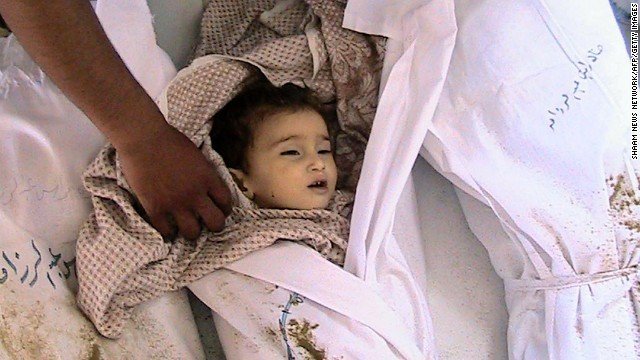The largest numbers of Syrians being killed are outside combat, in small towns like this one.
“We are alone”
The doctor covers his ears, my hands begin to shake, and we drop toward the floor. Interview interrupted. Shells are falling directly on the town of Khan Assobl, and war roars through the once tidy calm of a rural home.
Khan Assobl is one place among many. A rough-hewn northern Syrian town in a rustic province called Idlib. As Syria moved beyond revolution to stagnated civil war, this old landscape of flinty crests and gnarled trees was put toward new use, excavated by both civilians and rebel soldiers for underground protection from aerial bombardment and shelling from the nearby Syrian Army outposts. If there was a time when war might have passed through Khan Assobl, the territory claimed by one side or another, that is over. Now the war never leaves. Rebels lob artillery into government positions, and the regime strikes at everything it can””mostly civilian areas like Khan Assobl.
Dr. Safah begins to stand; the initial shell shock fades, and duty kicks in. Someone could be hurt out there. Mahmood, the ambulance driver, is already out the door. Steady shellfire goes on as he rushes toward his vehicle, through ashen smoke, blasted earth, and the smell of freshly shattered stone. The engine sputters to a start on shabbily refined petrol. Lights flash, sirens howl, and the “sayyarat issaaf” car of the emergency shifts into motion, its rear sliding door still open.
“When we go on a mission, we expect to die,” says Mahmood. “It is a good death. Yes, a good death, because I face death to help people.”
Dr. Safah and I follow Mahmood’s ambulance, driving toward the place where we think the shells have struck. We swerve past potholes on country roads altered by war”™s presence. The past is here. Signs point toward the Ebla ruins, the Idleb Hotel, camping sites. They are echoes of a life before the war. The present is here too. Bullet holes fill road signs, their jagged edges rusted with the passing of time. In quieter hours, country boys running errands on horses touch their heads when you pass, and old men herding sheep raise their staffs and greet you with the old Ottoman word “Effendi.”
Rebel fighters fire; when the regime responds, it tends to target civilians as well as opposition forces.
We reach flat, parched grass on the road’s edge, and I look to Dr. Safah. He is a big, bull-like man, whose broad shoulders, heavy hands, and long Sunni beard are offset by kind eyes that fill with tears each time a child is killed.
A child has been killed. When we reach a Chinese-made pickup truck near where the shells landed, we see him. His name was Hussein Safah. He was 6 years old.
We find Hussein on the back of the pickup, placed by neighbors to take him to the cemetery field. His skull is broken and hollow. His body has been split in half. A knot of men in baseball caps look sullenly on, their hands on their hips, their heads held low. Just minutes earlier, the boy had been playing in his garden nearby. Now there is blood on the wall, a single shoe, and the smell of explosives.
Wrapped in a cheap rug, Hussein is being lowered into one of a dozen open graves that the people of Khan Assobl keep ready for their family, neighbors, and friends. He is buried quickly so that his mother doesn’t have to see him this way. There is another reason there will be no funeral: the regime bombs funerals””they kill more people that way.
Government-ordered indiscriminate shelling. It means that day after day, civilians have become unwitting players in a conflict that was not theirs, victims of a kind of collective punishment by a regime targeting its own citizens. I’ve seen war before, but I don”™t understand this strategy. Citadels of government force lie surrounded by valleys of a rebel population, both martial and innocent. Rebels fire crude artillery toward encircled regime military bases. When the regime fires back, it is erratic, aimed at nothing but people, whoever they may be.
Amid talk of chemical weapons, red lines, and jihadis, what is forgotten is the fact that the largest numbers of Syrians being killed are people outside combat, in their gardens, in small towns like this one. We are now in the third year of bloodshed. There have been 93,000 killed, according to the United Nations; as many as 120,000, according to the Syrian Observatory for Human Rights. The truth is, we don”™t know how many, because there are so many, most of them civilians.
“Syrians have just become numbers,” Dr. Safah says.
But the numbers have names. Hussein is one. Killed by a single shell, one of 40, another number, dropped on this rural place one afternoon, a quantity utterly insignificant in the wreckage. How many more numbers will there be? Syrians already know the answer. “Mu muhem,” says Mahmood. It does not matter. “We are alone.”



COMMENTS